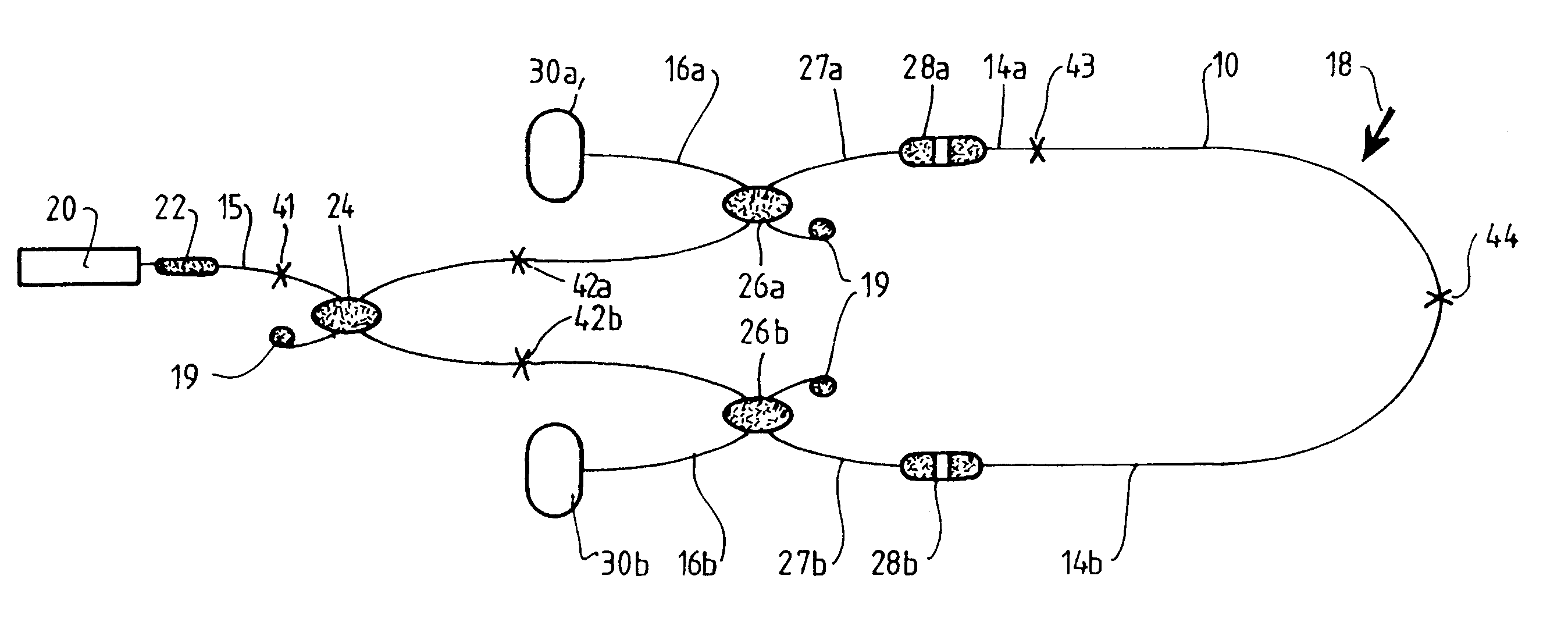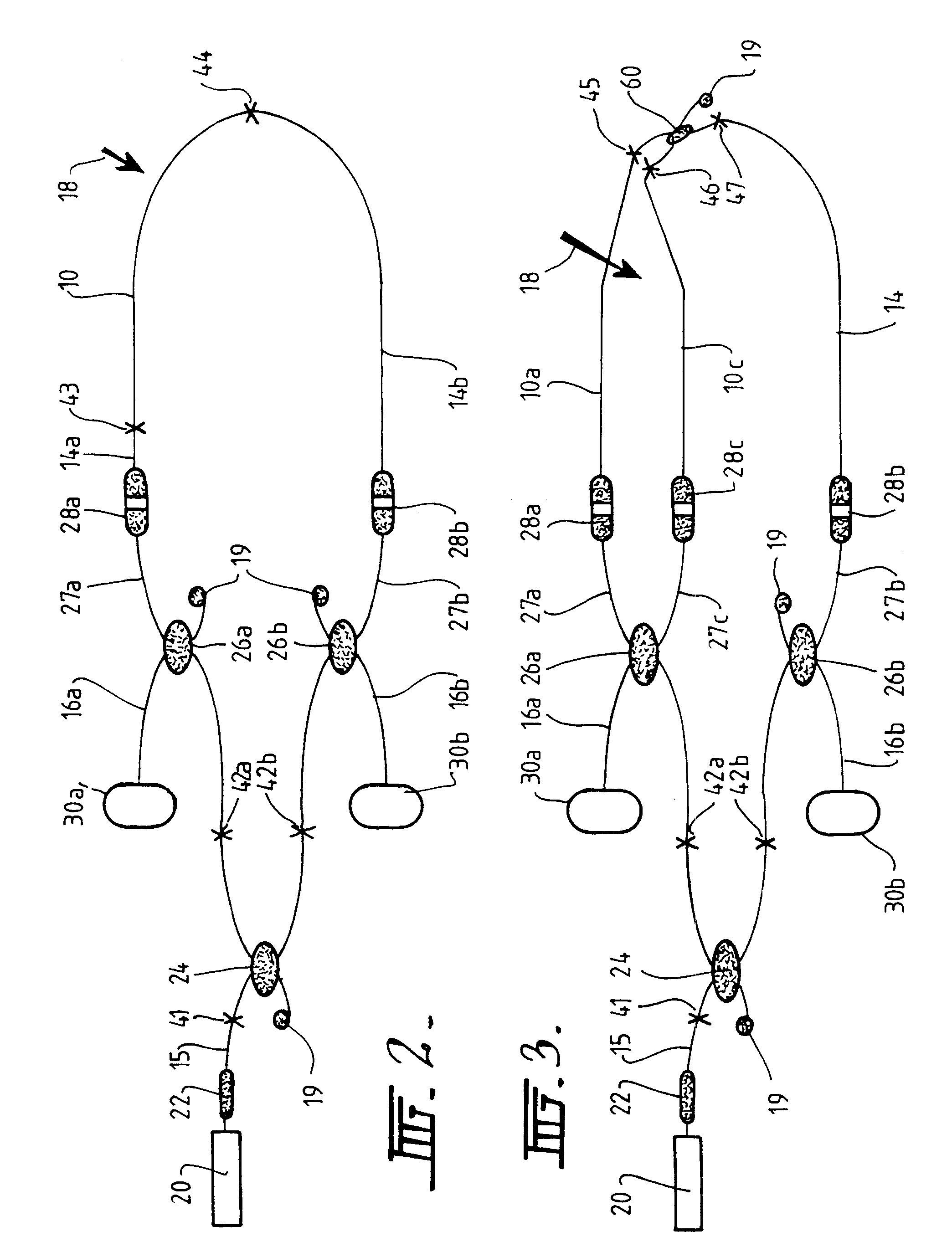The present invention relies on the measurement of the time delay or difference between transmissive counter-propagating optical signals affected by the same event. In this novel arrangement, optical signals, preferably continuous-wave (CW) optical signals, are launched, preferably from a single
light source, into the waveguide and simultaneously detected by a
detector such as two separate photodetectors. Pulsing of the optical
signal is not necessary, although it may be employed in some arrangements. Any sensed parameter which acts to alter the counter-propagating signals will effect both signals in the same manner, but because the effected counter-propagating signals must each continue travelling the remainder of the waveguide length to their respective photodetectors there is a
resultant time delay or
time difference between the detected signals. The time delay is directly proportional to the location of the sensed event along the waveguide length. Therefore, if the time delay or difference is detected and measured, the location of the event can be determined. At the same time, if a compatible sensing mechanism is being employed the sensed event can be quantified and / or identified (ie., strain, vibration,
acoustic emission, temperature transient, etc.). In addition, non-sensitive fibre optic delay lines may be connected to the waveguide at either or both ends in order to add additional delay between the transmissive counter-propagating signals and to provide insensitive lead fibres. This may assist
engineering the technique into a practical working
system.
The invention also has the
advantage of operating on virtually any existing type of transmissive distributed fibre
optic sensor, enabling dynamic and transient events to be detected, quantified and located anywhere along the length of the optical fibre which forms the waveguide. Furthermore, it operates in a transmissive configuration, thus, delivering substantially the entire optical
signal and power back to the detector and not requiring
signal averaging, and it determines the location of events via the time delay measurement between counter-propagating optical signals effected by the same disturbance.
Preparing or connectorising the free ends of the fibre leads in any manner which facilitates attaching, connecting, splicing or
coupling the fibre leads to the appropriate combination and arrangement of light source, couplers, photodetectors and
signal processing electronics which achieves the transmissive counter-propagating signal method for locating events in optical waveguides.
In an alternate arrangement, the sensor fibre may be replaced by two or more suitably configured optical fibres (single or multi moded) and additional couplers may be utilised to connect the plurality of sensor fibres to the fibre optic leads. In this arrangement, a further number of couplers and photodetectors may be required at the
instrumentation to facilitate the increased number of sensing and lead fibres.
In the method, according to the preferred embodiment of the invention,
electromagnetic radiation is launched into an optical waveguide (single or multi moded), such as an optical fibre, from a light source, such as a pigtailed
laser diode, fibre
laser or
light emitting diode, and propagates along the optical waveguide. The optical waveguide is connected (temporarily or permanently) to one arm of an optical waveguide light splitter or coupler and when the
electromagnetic radiation reaches the light splitter the electromagnetic
radiation can
branch out into the two output waveguide arms of the light splitter. Each of the output arms of this light splitter are fusion spliced to other couplers, thus the
optical radiation from the
laser source is simultaneously launched into each of the other two couplers. These two couplers form the launch and detection ports for the dual-ended, counter-propagating method described above. The optical signal is simultaneously launched to the output waveguide arms of the couplers. Only one output arm is used in each coupler, the other is fractured or otherwise terminated to avoid back-reflections. The output arms of the couplers are either connected (temporarily or permanently) directly to the waveguide sensing element or to a lead optical waveguide which is connected (temporarily or permanently) to the waveguide sensing element. Any one of the output waveguide arms of the light splitter may be used to deliver the electromagnetic
radiation to the sensor waveguide via an optical waveguide lead. Likewise, a plurality of output waveguide arms may be used to deliver the electromagnetic
radiation to a number of individual or multiplexed waveguide sensors. Each of the counter-propagating signals transmitted into the
waveguide sensor propagates along the entire length of the waveguide until they reach the opposite ends and are launched back into the latter couplers in the opposite direction to the initial launch signals. The signals are each split in the reverse direction through the latter couplers. Part of the signals travel back towards the first coupler and laser, and the remainder of the signals travel along the unused arms of the latter couplers, which are terminated at photodetectors. The optical signals are simultaneously monitored by the two photodetectors. Appropriate
electronics,
signal processing schemes and algorithms process the signals from each detector and provide the location of the sensed event by determination of the time delay or difference between the signals effected by the same disturbance. The insensitive fibre optic leads may be very long to provide an additional time delay between the optical signals. This may assist
engineering the technique into a practical working
system.
 Login to View More
Login to View More 


